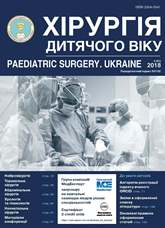Challenges in radiologic diagnostics of esophageal leiomyomas
DOI:
https://doi.org/10.15574/PS.2018.61.37Keywords:
leiomyoma, submucosa, esophagus, benign tumorsAbstract
Today there is a large number of oesophageal tumours, and the need for their differential diagnosis is conditioned of different treatment paradigm. This is especially true for oesophageal benign mass lesions (leiomyomas) and gastrointestinal stromal tumours (GIST). Since the most frequent and accessible examinations of patients with the upper gastrointestinal events are radiological methods, a necessity arises to evaluate their efficacy in differentiating between various oesophageal neoplasms and detecting oesophageal leiomyomas in the preoperative period.
Objective: to determine the efficacy of radiologic imaging techniques for the oesophageal leiomyoma detection.
Materials and methods. A retrospective chart review of 59 patients with oesophageal leiomyoma was carried out. The radiological methods conducted in patients were as follows: esophagography with aqueous barium solution (n=48), chest computed tomography with contrast enhancement (chest CT) (n=35), magnetic resonance imaging with contrast enhancement (chest MRI) (n=4).
Results. The sensitivity of radiological diagnostic methods is low and for X-rays made up 31.25 per cent, for chest CT – 22.85 per cent, and for MRI – 50 per cent.
Conclusions. Each particular method of radiological diagnostics does not have specific signs for oesophageal leiomyomas; however, using X-radiography, chest CT and MRI in a complex diagnostics allows more precisely determine a diagnosis.
References
Vlasov PV, Rabukhina NA. (2007). X-ray Examination of the oesophagus. Med. Vizualization. 5: 30–50.
Ostapenko TA, Yatsyk VI. (2005). Promeneva diahnostyka novoutvoren stravokhodu (lektsiia). Radiolohichnyi visnyk. 3: 22–24.
Prokop M. (red). (2006). Spiral'naja i mnogoslojnaja komp'juternaja tomografija uchebnoe. Posobie v 2h tomah. Tom 2. Moscow: MEDpress-inform: 349.
Saienko VF, Miasoiedov SD, Andreieshchev SA, Kondratenko PM, Kostyliev MV, Umanets MS ta in. (2006). Diahnostyka ta likuvannia leiomiomy stravokhodu. Klinich. khirurhiia. 10: 14–17.
Jang KM, Lee KS, Lee SJ et al. (2002). The spectrum of benign esophageal lesions: imaging findings. Korean J Radiol. 3: 199–210. https://doi.org/10.3348/kjr.2002.3.3.199.
Lee LS, Singhal S, Brinster CJ, Marshall B, Kochman ML, Kaiser LR et al. (2004). Current management of esophageal leiomyoma. J Am Coll Surg. 198(1): 136–46. https://doi.org/10.1016/j.jamcollsurg.2003.08.015
Lewis RB, Mehrotra AK, Rodriguez P, Levine MS. (2013, Jul-Aug). From the radiologic pathology archives: esophageal neoplasms: radiologic-pathologic correlation. Radiographics. 33(4): 1083–108. https://doi.org/10.1148/rg.334135027
Marini T, Desai A, Kaproth-Joslin K, Wandtke J, Hobbs SK. (2017). Imaging of the oesophagus: beyond cancer. Insights Imaging. 8(3): 365–376. https://doi.org/10.1007/s13244-017-0548-3; PMCid:PMC543831
Murawa D, Zieliński P, Spychała A, Dyszkiewicz W. (2014). Giant oesophageal leiomyoma as a diagnostic and therapeutic problem – a case report. Kardiochirurgia i Torakochirurgia Polska. 11(1): 79–82. https://doi.org/10.5114/kitp.2014.41938
Tsai SJ, Lin CC, Chang CW, Hung CY,Shien TY, Wang HY et al. (2015). Benign esophageal lesions: endoscopic and pathologic features. World J Gastroenterol. 21(4): 1091–1098. https://doi.org/10.3748/wjg.v21.i4.1091
Yang PS, Lee KS, Lee SJ, Kim TS, Choo IW, Shim YM, Kim K, Kim Y. (2001, Jul-Sep.) Esophageal leiomyoma: radiologic findings in 12 patients. Korean J Radiol. 2(3): 132–7. https://doi.org/10.3348/kjr.2001.2.3.132
Downloads
Issue
Section
License
The policy of the Journal “PAEDIATRIC SURGERY. UKRAINE” is compatible with the vast majority of funders' of open access and self-archiving policies. The journal provides immediate open access route being convinced that everyone – not only scientists - can benefit from research results, and publishes articles exclusively under open access distribution, with a Creative Commons Attribution-Noncommercial 4.0 international license(СС BY-NC).
Authors transfer the copyright to the Journal “PAEDIATRIC SURGERY.UKRAINE” when the manuscript is accepted for publication. Authors declare that this manuscript has not been published nor is under simultaneous consideration for publication elsewhere. After publication, the articles become freely available on-line to the public.
Readers have the right to use, distribute, and reproduce articles in any medium, provided the articles and the journal are properly cited.
The use of published materials for commercial purposes is strongly prohibited.

